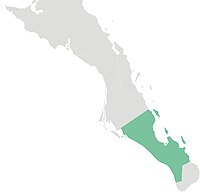El Centenario: Difference between revisions
Added Town Population, Location, Time Data |
|||
| Line 50: | Line 50: | ||
|population_as_of = |
|population_as_of = |
||
|population_note = |
|population_note = |
||
|population_total = |
|population_total = 3,626 |
||
|population_density_km2 = |
|population_density_km2 = |
||
|population_density_sq_mi = |
|population_density_sq_mi = |
||
| Line 57: | Line 57: | ||
|population_density_metro_sq_mi = |
|population_density_metro_sq_mi = |
||
|population_urban = |
|population_urban = |
||
|timezone = [[ |
|timezone = [[Mountain Time]] |
||
|utc_offset = - |
|utc_offset = -7 |
||
|timezone_DST = |
|timezone_DST = |
||
|utc_offset_DST = |
|utc_offset_DST = |
||
|latd = |
|latd = 240400 |
||
|longd = |
|longd = 1102452 |
||
|elevation_m |
|elevation_m = 15 |
||
|elevation_ft = |
|elevation_ft = |
||
|postal_code_type = |
|postal_code_type = |
||
Revision as of 17:32, 1 November 2007
El Centenario | |
|---|---|
 El Centenario Hillside, From The Beach | |
 Location of El Centenario in Baja California Sur | |
| Country | Mexico |
| State | Baja California Sur |
| Founded | 1960's |
| Elevation | 15 m (49 ft) |
| Population | |
• Total | 3,626 |
| Time zone | UTC-7 (Mountain Time) |
| Website | http://www.lapaz.gob.mx |
| 1 INEGI, Enciclopedia de los Municipios de México | |
El Centenario is a small seaside town located in the Municipality of La Paz, Baja California Sur, Mexico, approximately 15 km north of the capital city of La Paz.
History
It was founded in the 1960's as an agrarian/fishing ejido by approximately 25 founding families. Each of the original families was delegated land to use for farming and on which to build a dwelling, while the land remained under the ownership of the communal ejido. During the 1990's, due to reforms associated with the North American Free Trade Agreement, Mexican ejidos were granted rights to deliver legal ownership of ejido land to the members, thus changing from communally ownership to private ownership.
Local Tradition
El Centenario locals eat nopal cacti prepared in tacos, which is unique in the La Paz area. This tradition was brought to El Centenario by the founding families when they moved from the interior of the Baja peninsula, where eating nopal is more common. In early fall, El Centenario holds a town nopal-themed festival. A carnival with rides and games is set up in the town center. A nopal cooking competition was held and a 'Nopal Princess' was selected during the 2007 festival.
Climate
The general year-around climate in El Centenario is warm, sunny, and dry.
Population
Since its establishment, El Centenario has grown as a suburb or satellite city of La Paz. As of November 2007, many El Centenario residents work at the San Juan De La Costa Mine and the Paradiso Del Mar Touristic Development on the El Mogote Peninsula, due the town's close proximity to those two locations.
In recent years, the hillside behind El Centenario has become a favorite location for United States and Canadian citizens to build new houses, either as a second vacation homes or as primary residences for retirement. The lower cost of living, when compared to the U.S., especially sunny California or Florida, plus the rapid modernization of Southern Baja, has made it an increasingly viable alternative to retiring in the southern United States.
References
- Link to tables of population data from Census of 2005 INEGI: Instituto Nacional de Estadística, Geografía e Informática
External links
- Viva Lapaz! La Paz Tourism Website
- Ayuntamiento de La Paz Official Website of Municipality of La Paz
- Haciendas Palo Verde Information About A Growing Meighborhood in El Centenario
